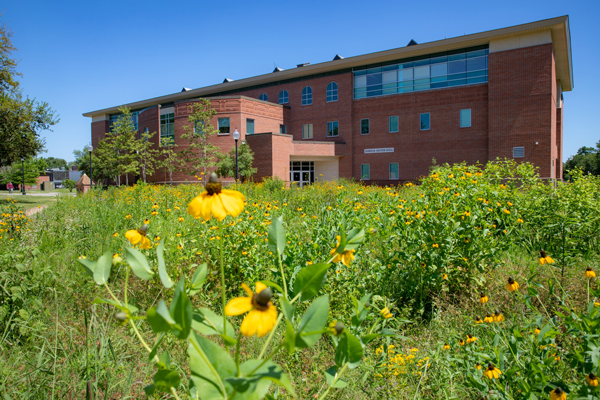The University of Louisiana at Lafayette made a splash with its storm water management plan.
Its plan – entitled The Ripple Effect: Community Cultivated, Regionally Replicated – won the Environmental Protection Agency’s 2018 Campus RainWorks Challenge in the Master Plan category. Forty-nine colleges and universities participated in the competition.
The plan outlines campus “green infrastructure” initiatives. The term refers to processes designed to decrease, slow and filter water that flows into drainage systems from buildings, streets and sidewalks.
Green infrastructure combats flooding and pollution. It has been a growing consideration for designers and developers in recent years, thanks to changing construction regulations geared toward sustainable building practices, said Gretchen LaCombe Vanicor, director of UL Lafayette’s Office of Sustainability.
The office released The Ripple Effect plan late last year. Methods being implemented or planned by the University include creating bioswales, installing rainwater collection systems and using permeable building materials.
A focus on sustainable building practices has become increasingly important, in part, “because of the large amount of rainfall we receive in this part of the country,” Vanicor said.
She cited unprecedented flooding in August 2016 that swamped 56 of 64 parishes in Louisiana, killed 13 people and caused billions of dollars in damage. In south Louisiana, more than 30 inches of rain fell. The deluge, which the National Weather Service characterized as a 1,000-year flood, left the state reeling.
“The flood demonstrated that our region – like many – can’t adequately handle extreme rain events. The Ripple Effect is designed to make our campus a ‘living lab’ for researching and developing green infrastructure strategies that will benefit and influence public officials, developers, businesses and homeowners,” Vanicor explained.
The first phase of the tiered Ripple Effect includes planting native grasses, provided by the University’s Ecology Center, along the banks of Coulee Mine. The coulee, which runs through the city and campus, funnels storm water into the Vermilion River.
Planting prairie grasses lessens erosion, helps filter contaminants and slows the rate at which water drains from campus.
Another initiative to help diminish the amount of water pouring into drainage systems will be the continued placement of retention ponds near new campus developments, said Bill Crist, director of Facility Management. Retention ponds have been dug for buildings at the University’s Research Park. One will also be positioned near the Heritage at Cajun Village residential apartments, which are being constructed at the corner of Johnston and East Lewis streets.
“Retention ponds reduce the risk for flash flooding because they fill with water that would otherwise pour into drainage systems very quickly,” Crist explained.
Another initial goal of the University’s green infrastructure plan is to increase the number of bioswales on campus. The shallow troughs hold plants and other vegetation. They act as sieves to remove silt and contaminants from rainwater.
Student volunteers collaborating with the Office of Sustainability and the Office of Facility Management have installed two bioswales. One sits between Burke-Hawthorne and V.L. Wharton halls. Another is between Oliver and Madison halls.
Future phases of The Ripple Effect include constructing sidewalks and parking lots with permeable pavement that absorbs rainwater instead of repelling it. Rainfall absorbed by permeable pavement eventually seeps into the ground, which lessens runoff from cascading onto rain-saturated green spaces.
A longer-range project involves installation of an aquifer storage and recovery system – a specialized well that holds excess rainwater. The stored water can be injected into the Chicot Aquifer.
Olivia LaHaye, a graduate student in civil engineering, is one of several student researchers who contributed to The Ripple Effect. As part of her master’s thesis, she is conducting a feasibility study to research processes for replenishing the Chicot Aquifer.
Water is being pumped from the massive underground layer of water in southwest Louisiana more quickly than it can be replaced by nature. Without a steady supply of freshwater, saltwater is infiltrating the aquifer from coastal areas.
“Surface reservoirs are one of the most common methods for storing water that could be used to replenish the aquifer, but that water is vulnerable to evaporation, seepage and contamination,” LaHaye explained.
Blair Begnaud and other architecture students helped LaCombe compile research for The Ripple Effect. Among many duties, she researched areas of campus where water tended to pool and potential ways sustainable architectural design could be integrated into campus buildings constructed long ago.
Begnaud also collaborated with University offices, departments and other students who assisted the Office of Sustainability.
The work has influenced her career path, as did the fact that her own house flooded in 2016.
She will start a job at an architectural firm in Fayetteville, Arkansas after she earns her master’s degree in May. “Sustainability projects, including city planning, will be part of my responsibilities. It makes me both proud and confident that I studied at a University that is a national leader in storm water management.”
The EPA award brings more than a pat on the back for a job well done.
For its win, the University received a $5,000 prize. “The money will be put right back into storm water-mitigation related projects, and to support research and education,” Vanicor said.
Learn more about The Ripple Effect
Photo: Increasing the number of bioswales on the University of Louisiana at Lafayette campus is one objective outlined in the its green infrastructure plan. The shallow troughs hold plants and other vegetation. They act as sieves to remove silt and contaminants from rainwater. Rachel Keyes/University of Louisiana at Lafayette
